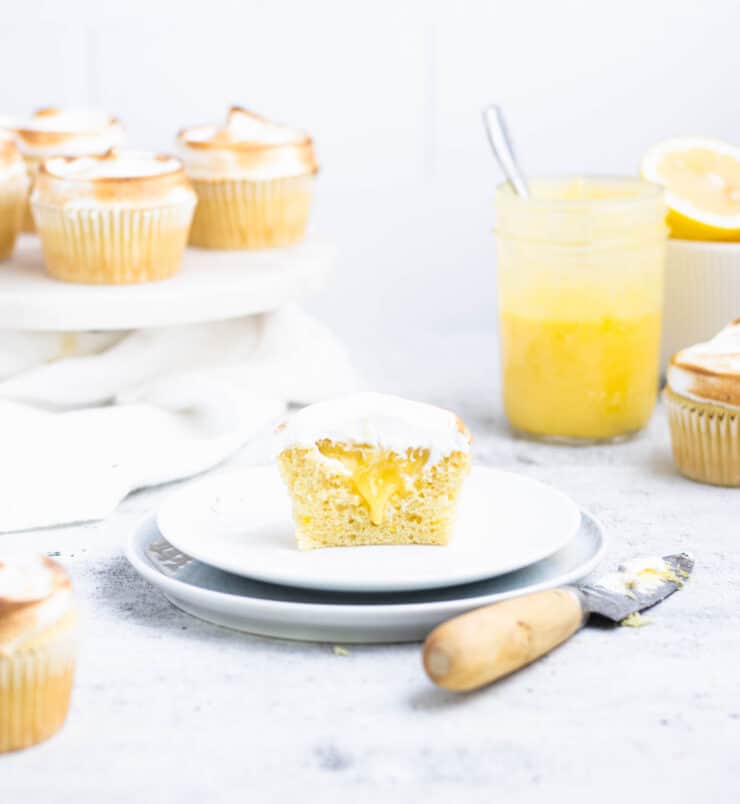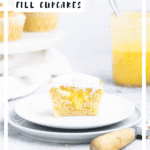Cupcakes, but make them even better. In this post you'll learn how to fill cupcakes using a simple technique with a tool you already have to create any one of a number of unique and delicious flavor combinations.

If joy isn't biting into a delicious cupcake only to discover a sweet surprise-inside filling, I don't know what is.
And because this is one of my favorite ways to add a little magic to my baking (I mean, that and copious amounts of sprinkles), I want to share my favorite method for doing it.
This is a no frills, no fancy kitchen tools need kind of method. Which is my favorite. Because I don't have anymore cabinet or drawer space for tools.
All you'll need is a paring knife, a filling and a batch of your favorite cupcakes.
How to choose the right cupcake
While we love all cupcakes equally here, not every variety is destined for filling. Because filling a cupcake requires removing the center, the ideal candidate is one that's sturdy enough to hold it's shape, even after the first bite.
Most cupcakes, including those adapted from a box mix, will work well.

Types of cakes to avoid include:
- Sponge cakes: These delicate cakes (like these angel food cake cupcakes) tend to be too soft to core and, because of their dryness, are likely to soak up an moisture in the filling. This can result in a soggy cupcake or one that just falls a part.
- Cakes with large chunks: The large chunks in cakes like this pineapple carrot cake make them difficult to core.
Select a filling
The sky is very nearly the limit when it comes to fillings. Almost any frosting, jam, curd or spread will work.

Fillings to avoid include:
- Liquids: Anything that runs the risk of being absorbed by the surrounding cake or running out onto your face immediately after biting into it won't make a great filling. Caramel can work well if it's a spread rather than a sauce.
- Foods that aren't stable at room temperature: Requiring refrigeration is one thing (and isn't an immediate disqualifier for a filling), but not being stable at room temperature is another. This includes foods like ice cream
- Fillings that are denser than the cupcake: While it's possible to fill cupcakes with something denser than the surrounding cake, it can make for an unpleasant experience.
How to fill cupcakes
Once the cupcakes are baked and have cooled completely, they're ready to be filled. They can also be refrigerated for 30 minutes, which will make them easier to cut/handle and less likely to be squished when cored.

First, cut out the center of the cupcakes.
While there are lots of kitchen tools made specifically for coring various kinds of food, I prefer a paring knife; It's precise, I can tailor the size of the hole to the cupcake and the amount of filling I want and it means one less tool to store.
Holding your paring knife at a 45 degree angle, insert the knife into the top of the cupcake about ¼" from the edge.

Using a gentle sawing motion, cut around the top of the cupcake keeping the outer edge of the knife no less than ¼" from the edge.
A quick note on depth:
While you can create a fairly deep cavity, be sure you're not cutting all the way through to the bottom.
Once you come all the way back around to where you first inserted the knife, you should be able to turn out a cone shaped piece of cake.

Second, add your filling.
Spoon a filling of your choice into the center of the cupcake leaving about ¼" of space from the top.
Trim the wide end of the cone of cake to ¼".
Note:
You can skip this step but I like to do it to head off any potential issues from the two coming into contact with each other, especially if I'm not serving them immediately.

Finally, frost your cupcakes.
Use the trimmed piece of cake to cover the filling.
Frosting with frosting of your choice and store or serve immediately.
A note on storage:
Some fillings and cupcakes will keep well after being filled and others may be better filled immediately prior to serving, so keep this in mind as you're planning your baking/assembly.
Expert tips
- Storing filled cupcakes: While cupcakes are always best when eaten the same day they’re made, these can be stored in an air-tight container at room temperature (unless their filling requires refrigeration) for 1-2 days.
- Cupcakes are best served at room temperature: Even if the filling requires refrigeration, cake tastes best at room temperature. Be sure to remove your cupcakes from the refrigerator at least an hour before serving.
Recipes for filled cupcakes
Frequently asked questions
It depends on the filling. While fillings like chocolates and cream cheese can hold up to being baked, others will change during the baking process or will disintegrate entirely. If in doubt, add them after baking.
Fillings with a lot of liquid can make cupcakes soggy and should be avoided.
While most cupcakes can be stored at room temperature, cupcakes that have dairy or egg-rich frostings or fillings may require refrigeration.





Leave a Reply